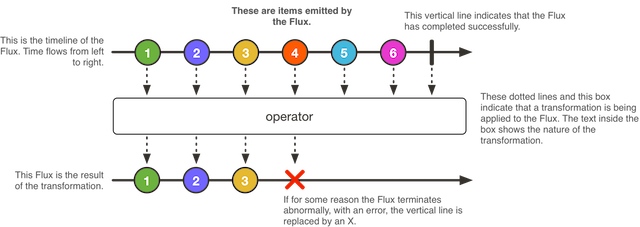Non-Blocking Reactive Streams Foundation for the JVM both implementing a Reactive Extensions inspired API and efficient event streaming support.
Since 3.3.x, this repository also contains reactor-tools, a java agent aimed at helping with debugging of Reactor code.
Reactor 3 requires Java 8 or + to run.
With Gradle from repo.spring.io or Maven Central repositories (stable releases only):
repositories {
mavenCentral()
// Uncomment to get access to Milestones
// maven { url "https://repo.spring.io/milestone" }
// Uncomment to get access to Snapshots
// maven { url "https://repo.spring.io/snapshot" }
}
dependencies {
compile "io.projectreactor:reactor-core:3.7.1"
testCompile "io.projectreactor:reactor-test:3.7.1"
// Alternatively, use the following for latest snapshot artifacts in this line
// compile "io.projectreactor:reactor-core:3.7.2-SNAPSHOT"
// testCompile "io.projectreactor:reactor-test:3.7.2-SNAPSHOT"
// Optionally, use `reactor-tools` to help debugging reactor code
// implementation "io.projectreactor:reactor-tools:3.7.1"
}See the reference documentation for more information on getting it (eg. using Maven, or on how to get milestones and snapshots).
Note about Android support: Reactor 3 doesn't officially support nor target Android. However it should work fine with Android SDK 21 (Android 5.0) and above. See the complete note in the reference guide.
Since the introduction of Java Multi-Release JAR File support one needs to have JDK 8, 9, and 21 available on the classpath. All the JDKs should be automatically detected or provisioned by Gradle Toolchain.
However, if you see error message such as No matching toolchains found for requested specification: {languageVersion=X, vendor=any, implementation=vendor-specific} (where
X can be 8, 9 or 21), it means that you need to install the missing JDK:
Installing JDKs with SDKMAN!
In the project root folder run SDKMAN env initialization:
sdk env installthen (if needed) install JDK 9:
sdk install java $(sdk list java | grep -Eo -m1 '9\b\.[ea|0-9]{1,2}\.[0-9]{1,2}-open')then (if needed) install JDK 21:
sdk install java $(sdk list java | grep -Eo -m1 '21\b\.[ea|0-9]{1,2}\.[0-9]{1,2}-open')When the installations succeed, try to refresh the project and see that it builds.
The manual Operation-system specific JDK installation is well explained in the official docs
The current active shell JDK version must be compatible with JDK17 or higher for Antora to build successfully. So, just ensure that you have installed JDK 21, as described above and make it as the current one.
Then you can build the antora documentation like this:
./gradlew docsThe documentation is generated in docs/build/site/index.html and in docs/build/distributions/reactor-core-<version>-docs.zip
If a PDF file should also be included in the generated docs zip file, then you need to specify -PforcePdf option:
./gradlew docs -PforcePdfNotice that PDF generation requires the asciidoctor-pdf command to be available in the PATH.
For example, on Mac OS, you can install such command like this:
brew install asciidoctorNew to Reactive Programming or bored of reading already ? Try the Introduction to Reactor Core hands-on !
If you are familiar with RxJava or if you want to check more detailed introduction, be sure to check https://www.infoq.com/articles/reactor-by-example !
A Reactive Streams Publisher with basic flow operators.
- Static factories on Flux allow for source generation from arbitrary callbacks types.
- Instance methods allows operational building, materialized on each subscription (Flux#subscribe(), ...) or multicasting operations (such as Flux#publish and Flux#publishNext).
Flux in action :
Flux.fromIterable(getSomeLongList())
.mergeWith(Flux.interval(100))
.doOnNext(serviceA::someObserver)
.map(d -> d * 2)
.take(3)
.onErrorResume(errorHandler::fallback)
.doAfterTerminate(serviceM::incrementTerminate)
.subscribe(System.out::println);A Reactive Streams Publisher constrained to ZERO or ONE element with appropriate operators.
- Static factories on Mono allow for deterministic zero or one sequence generation from arbitrary callbacks types.
- Instance methods allows operational building, materialized on each Mono#subscribe() or Mono#get() eventually called.
Mono in action :
Mono.fromCallable(System::currentTimeMillis)
.flatMap(time -> Mono.first(serviceA.findRecent(time), serviceB.findRecent(time)))
.timeout(Duration.ofSeconds(3), errorHandler::fallback)
.doOnSuccess(r -> serviceM.incrementSuccess())
.subscribe(System.out::println);Blocking Mono result :
Tuple2<Instant, Instant> nowAndLater = Mono.zip(
Mono.just(Instant.now()),
Mono.delay(Duration.ofSeconds(1)).then(Mono.fromCallable(Instant::now)))
.block();Reactor uses a Scheduler as a contract for arbitrary task execution. It provides some guarantees required by Reactive Streams flows like FIFO execution.
You can use or create efficient schedulers to jump thread on the producing flows (subscribeOn) or receiving flows (publishOn):
Mono.fromCallable( () -> System.currentTimeMillis() )
.repeat()
.publishOn(Schedulers.single())
.log("foo.bar")
.flatMap(time ->
Mono.fromCallable(() -> { Thread.sleep(1000); return time; })
.subscribeOn(Schedulers.parallel())
, 8) //maxConcurrency 8
.subscribe();ParallelFlux can starve your CPU's from any sequence whose work can be subdivided in concurrent
tasks. Turn back into a Flux with ParallelFlux#sequential(), an unordered join or
use arbitrary merge strategies via 'groups()'.
Mono.fromCallable( () -> System.currentTimeMillis() )
.repeat()
.parallel(8) //parallelism
.runOn(Schedulers.parallel())
.doOnNext( d -> System.out.println("I'm on thread "+Thread.currentThread()) )
.subscribe()To bridge a Subscriber or Processor into an outside context that is taking care of
producing non concurrently, use Flux#create, Mono#create.
Flux.create(sink -> {
ActionListener al = e -> {
sink.next(textField.getText());
};
// without cancellation support:
button.addActionListener(al);
// with cancellation support:
sink.onCancel(() -> {
button.removeListener(al);
});
},
// Overflow (backpressure) handling, default is BUFFER
FluxSink.OverflowStrategy.LATEST)
.timeout(Duration.ofSeconds(3))
.doOnComplete(() -> System.out.println("completed!"))
.subscribe(System.out::println)Most of this cool stuff uses bounded ring buffer implementation under the hood to mitigate signal processing difference between producers and consumers. Now, the operators and processors or any standard reactive stream component working on the sequence will be instructed to flow in when these buffers have free room AND only then. This means that we make sure we both have a deterministic capacity model (bounded buffer) and we never block (request more data on write capacity). Yup, it's not rocket science after all, the boring part is already being worked by us in collaboration with Reactive Streams Commons on going research effort.
"Operator Fusion" (flow optimizers), health state observers, helpers to build custom reactive components, bounded queue generator, converters from/to Java 9 Flow, Publisher and Java 8 CompletableFuture. The repository contains a reactor-test project with test features like the StepVerifier.
https://projectreactor.io/docs/core/release/reference/docs/index.html
https://projectreactor.io/docs/core/release/api/
https://github.com/reactor/lite-rx-api-hands-on
https://www.infoq.com/articles/reactor-by-example
https://github.com/reactor/head-first-reactive-with-spring-and-reactor/
- Everything to jump outside the JVM with the non-blocking drivers from Reactor Netty.
- Reactor Addons provide for adapters and extra operators for Reactor 3.
Powered by Reactive Streams Commons
Licensed under Apache Software License 2.0
Sponsored by VMware




